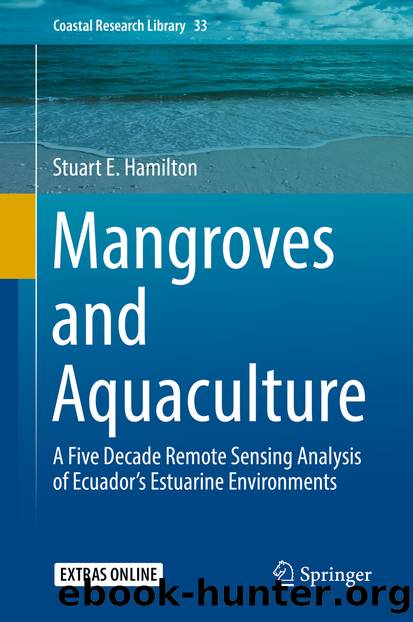Mangroves and Aquaculture by Stuart E. Hamilton

Author:Stuart E. Hamilton
Language: eng
Format: epub
ISBN: 9783030222406
Publisher: Springer International Publishing
3.5.2 Socioeconomic Conditions & Livelihoods
The city of Bahía de Caráquez at the mouth of the estuary is a tourist center with numerous condominiums, hotels, and guesthouses catering to international expatriates and visitors from the highlands. The tourism is mostly limited to Bahía de Caráquez with tourism occurring mostly in the dry season as well as over holidays including Carnival. The city is partly on the estuary and partly on the ocean. Aside from the fish, shrimp, and other seafood served in the tourist restaurants, the city of Bahía de Caráquez has only limited livelihood connections to the estuary or mangrove forests. Tourists in Bahía may visit the mangrove forests of the estuary for a day trip, and some even venture inland as far as the Segua Wetland.
Away from the major cities, numerous small fishing communities reside on the terrestrial edge of the estuary, and residents in these communities have traditionally made their living from the goods and services offered by the estuary. For example, on the northern shore of the estuary in the rural communities east of the town of San Vicente (Fig. 3.7), 80% of the households are dependent on the estuary for their income from fishing, while only 10% are reliant on either tourism or agriculture. In Sucre community, 80% of the households rely fishing and 20% on the collection of mollusks and crustaceans (Capitulo 2008). Capitulo (2008) provides an exhaustive and detailed list of livelihoods provided by the mangrove forests, including building material, charcoal, tannins, alcohol, direct foodstuffs, and medicinal uses.
The artisanal fishers appear well organized in this region, representing themselves through a union (Fig. 3.8, Panel 1) as opposed to relying on non-governmental organizations (NGOs) as in Muisne or Cojimies. Many of the artisanal fishers now rely on ecotourism as opposed to fishing or harvesting in the estuary. For example, the small fishing community in and around Portovelo on the north side of the estuary has rebranded itself as the Isla Corazón Ecotourism Community (Fig. 3.8, Panel 4) and offers tourists shrimp lunches and tours of the estuary. Particularly popular is the canoe track through the center of Isla Corazón (Fig. 3.8, Panel 2 & 3). These ecotourism-driven former fishermen are responsible for much of the mangrove forest replanting that occurs in the estuary. Fishing and crab or concha harvesting are much reduced from earlier periods, and the region is dotted with former processing plants for shrimp and other species that are no longer in operation (Fig. 3.8, Panel 6). It is likely these plants also served the nascent shrimp farm industry in the 1980s and 1990s before all the processing moved to the port area of Guayaquil.
Fig. 3.8Chone estuary and ecotourism opportunities
Caption – Panel 1 is the artisanal fisher union building in Bahia de Caraquez. Panel 2 is taken from the cliffs around the estuary and shows the Isla Corazón mangrove forest in the top left and shrimp farms in the top right. Panel 3 is an artisanal community canoe tour through the mangrove forests of Isla Corazón.
Download
This site does not store any files on its server. We only index and link to content provided by other sites. Please contact the content providers to delete copyright contents if any and email us, we'll remove relevant links or contents immediately.
Sass and Compass in Action by Wynn Netherland Nathan Weizenbaum Chris Eppstein Brandon Mathis(7397)
Drawing Shortcuts: Developing Quick Drawing Skills Using Today's Technology by Leggitt Jim(2528)
Hands-On Unity 2022 Game Development by Nicolas Alejandro Borromeo(2437)
The 46 Rules of Genius: An Innovator's Guide to Creativity (Voices That Matter) by Marty Neumeier(2305)
Autodesk Civil 3D 2024 from Start to Finish by Stephen Walz Tony Sabat(2194)
Rapid Viz: A New Method for the Rapid Visualization of Ideas by Kurt Hanks & Larry Belliston(2189)
Learn Qt 5: Build modern, responsive cross-platform desktop applications with Qt, C++, and QML by Nicholas Sherriff(2172)
Mathematics for Game Programming and Computer Graphics by Penny de Byl(2094)
Fusion 360 for Makers by Lydia Sloan Cline(1983)
Hands-On Neural Networks with Keras by Niloy Purkait(1865)
Taking Blender to the Next Level by Ruan Lotter(1776)
Mastering GUI Programming with Python by Alan D. Moore(1747)
Express Your Creativity with Adobe Express by Rosie Sue(1742)
Game Physics Cookbook by Gabor Szauer(1571)
Creative Character Design by Bryan Tillman(1555)
Unreal Engine 4 Game Development Quick Start Guide by Rachel Cordone(1420)
Hands-On GUI Application Development in Go by Andrew Williams(1414)
Qt 5 and OpenCV 4 Computer Vision Projects by Zhuo Qingliang(1394)
Mastering Graphics Programming with Vulkan by Marco Castorina | Gabriel Sassone(1369)
